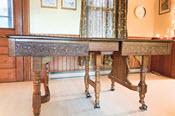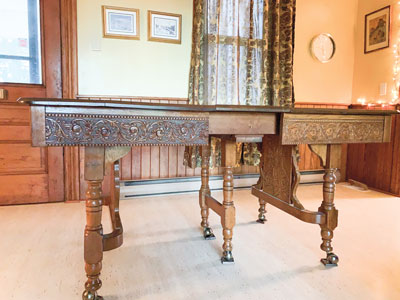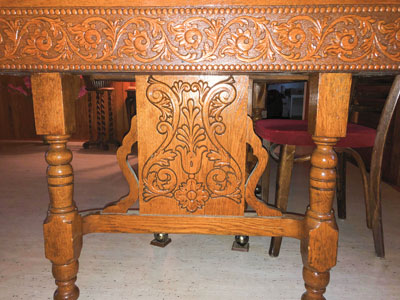
Hand-Carved Tables Bring Fond Memories of Mealtimes Past
By Ralph Winfield
As noted in an earlier article, the T. Eaton Company provided an extensive shopping experience, especially for rural people. Their catalogue provided many smaller items that were appreciated as birthday or Christmas presents. But more importantly, the company provided many larger items.
This included houses. But wait ‒ I just got a note (email) from a longtime friend who now lives in Saskatchewan. His father had been an executive with the T. Eaton Company in Toronto. Thus, he still has an interest in T. Eaton memorabilia.
He sent me a listing for an original T. Eaton house that’s for sale. The problem is that it has to be moved. It has three levels, a cedar exterior and a wraparound deck. I’m not providing the phone number, as I doubt if any of you would be interested.
The T. Eaton Company also sold furniture. Most rural farmhouses required a large dining room table for the family and/or the threshing gang. The Thomson family, my in-laws, had acquired one of those large tables.
The farmhouse had been expanded in 1910 to provide a large eating area, in addition to the dining room. The good news is that we still have that table in the farmhouse. It’s still an attention getter and now graces the family room where daily meals are served.
The table is 40 inches (104 cm) wide with a fully extended length of eight feet (244 cm) when all four of the table boards are added.
The centered double leg(s) actually move whenever boards are added or removed. Thus, they provide support at the center of the table at all times. Most of the newer extendable dining tables just have extendable tops. The four legs do not move.

The Thomson table had become rather unattractive after many years of general use at the farm. It had been used during annual wallpapering and other household projects. The large dining room area still exists. My father-in-law decided, after we moved to the farm, to have the old table refinished by a professional restorer. As a result, it now has a beautiful finish, as you can see in the recent photos.
Some of my friends with woodworking expertise assure me that all the intricate carving on the table was done by hand. The legs, of course, would have been turned on a lathe. The carved details on the end sections, the top support and the central support are still very detailed and attention getters.

A 2021 Christmas gift catalogue from Lee Valley Tools in Ottawa offers ‘chip carvers’ and shows detailed hand carvings very similar to those on the table.
If you have an interest in wood you have probably already noticed the Georgia pine wainscoting behind the table. It was placed when the house addition was added in 1910. Every spring it received a coat of varnish.
When we moved to the farm in 1974, my wife spent many days removing all the varnish. She sealed it and no coatings have been added since. The wainscoting and table are both still very attractive.
Other similar tables
In my many years of helping with threshing and viewing large tables, I have actually only seen one other table exactly like it. It was in Vancouver, B.C. just a few years ago. The owner’s father had been raised north of the, then much smaller, Metro Toronto Area. The son had obviously acquired it as a family heirloom. It too had been professionally restored.
The harvest brigades
I remember when many young Ontario men went West as part of the annual harvest brigade.
Most western farmers required assistance when threshing their massive grain crops. At that time, the host families would also have required large tables to seat the family and/or the threshing gang.
I well remember serving on local threshing gangs in Waterloo Region in the 1950s. Large tables were also required in all those farm kitchens or eating areas to accommodate a hungry group at one sitting.
The development of self-propelled grain combines had only started in the 1950s. Their widespread use eventually made the temporary movement of farm labour westward at harvest time redundant. In addition, many custom combine operators moved their combine fleet northward from the U.S. into Western Canada as the grain crops ripened.
I remember my older brother going West in the 1950s as part of the brigade to help with the grain harvest. Being mechanically inclined, he actually got to drive a new combine rather than pitch sheaves or feed a threshing machine. His colleagues were very envious.
Other uses of the T. Eaton catalogue
I’ve read that the relatively thick T. Eaton catalogues were also very useful as shin pads when strapped to the lower part of the legs.
While I did play hockey on rural frozen ponds. I don’t recall using shin pads. I’m sure that the catalogues had many other practical uses as well. BF



Post new comment